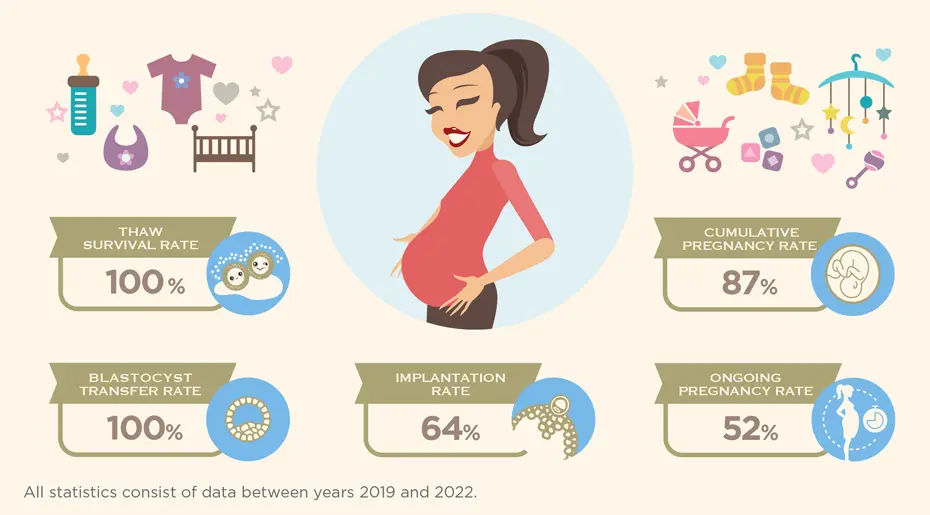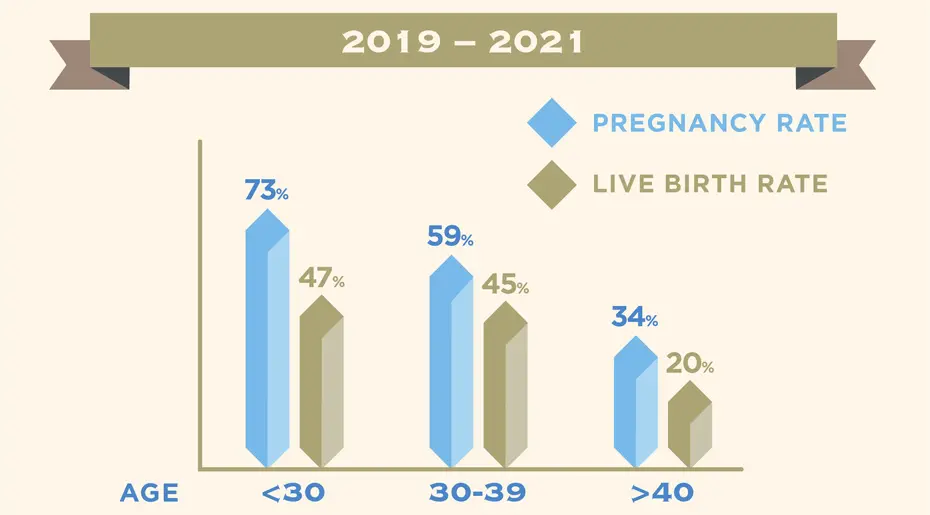-
-
Featured Care Areas

We are pleased to announce that Mount Elizabeth Fertility Centre is now open at our new location at The Heeren.

Mount Elizabeth Fertility Centre
Our IVF Edge
Our IVF success rates
Our comprehensive expertise in modern technologies and protocols have helped us to achieve high IVF success rates. We are committed to partnering with you in achieving parenthood, regardless of your age or level of response to fertility medications.
Based on data from 2019 – 2022, our key success rates are as follows:
- Thaw survival rate: 100%
- Blastocyst transfer rate: 100%
- Implantation rate: 64%
- Ongoing pregnancy rate: 52%
- Cumulative pregnancy rate: 87%
Our pregnancy rates are:
- 73% for women under 30 years old
- 59% for women aged 30 to 39 years old
- 34% for women over 40 years old
Our live birth rates are:
- 47% for women under 30 years old
- 45% for women aged 30 to 39 years old
- 20% for women over 40 years old
Note: The statistics are based on data from 2020 to 2022.
Pregnancy success rates
For a detailed breakdown of our pregnancy rates, please refer to the table below, which indicates the percentage of pregnancies over the number of frozen embryo transfers.
| Age | 2019 | 2020 | 2021 | 2022 |
|---|---|---|---|---|
| < 30 | 100% | 78% | 67% | 73% |
| 30 - 34 | 58% | 67% | 55% | 63% |
| 35 - 39 | 51% | 66% | 51% | 58% |
| 40 - 44 | 52% | 30% | 36% | 38% |
| Total | 56% | 55% | 46% | 54% |
Live birth success rates
For a detailed breakdown of our live birth rates, please refer to the table below, which indicates the percentage of live births over the number of frozen embryo transfers.
| Age | 2019 | 2020 | 2021 |
|---|---|---|---|
| < 30 | 80% | 56% | 40% |
| 30 - 34 | 42% | 58% | 47% |
| 35 - 39 | 39% | 45% | 46% |
| 40 - 44 | 31% | 15% | 27% |
| Total | 39% | 39% | 39% |
Note:
- Your success rate can be affected by your age, weight and cause of infertility. Individual results will vary with individual circumstances.
- Not every treatment cycle will result in an egg retrieval, an embryo transfer or embryo / blastocyst vitrification.
- For more information about understanding how to interpret IVF success rates, you can refer to the Human Fertilisation and Embryology Authority (HFEA).
Success rates of complicated IVF cases
Many of the cases we treat are complicated, and our consistent success rates are a testament to our expertise in fertility treatment.
- 39.21% of our cycles are performed on women with low ovarian or egg reserves (between 2020 to 2022)
- 73% of our treatment cycles are performed on patients who are either low responders or aged 40 and above (between 2020 to 2022)
Optimising IVF success rates
We aim to increase the chances of IVF success by:
- Adopting and constantly familiarising ourselves with technologies and protocols while upholding stringent quality control and laboratory standards
- Attracting skilled and experienced fertility specialists into our team, and continuously improving our services for better clinical outcomes
- Partnering with experts in the assisted reproductive technology (ART) field, such as Dr Mashashige Kuwayama, the head of Tokyo-based Repro-support Medical Research Centre and the inventor of the renowned Cryotec/Cyrotop method.
Success rate of freezing embryos
Mount Elizabeth Fertility Centre has been vitrifying (freezing) embryos since 2007. This technique allows for even safer and more efficient vitrification of eggs and embryos at a 100% survival rate.
Advanced IVF technologies at Mount Elizabeth
The major advances in IVF technology include:
- Advanced blastocyst culture system and transfer
- Double stimulation protocol
- Blastocyst vitrification (freeze-all IVF)
These methods have improved the number of live births in each stimulated IVF cycle, and have been routinely practised at Mount Elizabeth Fertility Centre since 2002.
In this section





